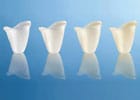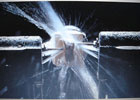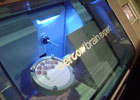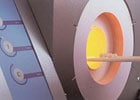What is a Zirconia crown?
A zirconia crown is a laminated ceramic crown, it consists of two distinct layers:
- A zirconium oxide cap, made by CAD/CAM(Computer Aided Design and Manufacturing).
- A surface part called "cosmetic" made of traditional ceramics mounted and fired layer by layer by a traditional ceramist.
- Not to be confused with a "Full Zirconia" crown, which consists of a single monolithic block of zirconia which is then made up.
The zirconia crown is nowadays the Nec Plus Ultra The zirconium crown is the most popular choice for dental crowns, especially in difficult anterior cases and/or when metal needs to be concealed, for example.
How is the zirconia coping made?
- A traditional impression of the tooth is made by your dentist.
- or even better, we can make a digital impression directly with the optical camera of our Digital CAD/CAM chain.
- If it is a conventional impression, it is cast in plaster by the dental technician, thus obtaining a replica of your tooth in the mouth.
- This plaster model is scanned by a 3D scanner, which allows to model your mouth in 3 dimensions.
- A specialised prosthetist (an info-prosthetist) will then virtually design your crown on the computer.
- Then a machine tool will machine a block of zirconia to make the cap.
- The screed is then placed in a furnace to obtain its final hardness (very close to that of metal).
All these steps are carried out in a laboratory in the Yvelines, by a team of experienced and qualified prosthetists.


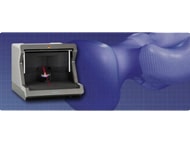
What are the advantages of a zirconia crown?
- It allows to obtain an aesthetic result close to perfection, indeed its optical properties facilitate the task of the ceramist who does not need to hide the metal anymore. There can no longer be an unsightly black border between the crown and the gum, as there is no longer any metal.
- Zirconia is biocompatible and hypoallergenic. Furthermore, bacteria have great difficulty in adhering to zirconia, which is why gingival integration is excellent.
- The CAD/CAM manufacturing technique is much more precise than a metal casting. This precision of around 10 µm allows the crown to be adapted to the tooth in a way that is not possible with a metal framework crown. The crown is therefore better adapted, more watertight and therefore more durable over time. The risk of recurrence of caries under the crown is significantly reduced.
- Zirconia has exceptional physical and chemical properties that guarantee a long-lasting result.
- Since February 11, 2010, ceramic crowns (including the Zirconia crown) are registered in the NGAP (Nomenclature Générale des Actes Professionnels), and today in the CCAM (Classification Commune des Actes Médicaux), as such they are reimbursed like all other crowns by Social Security.
